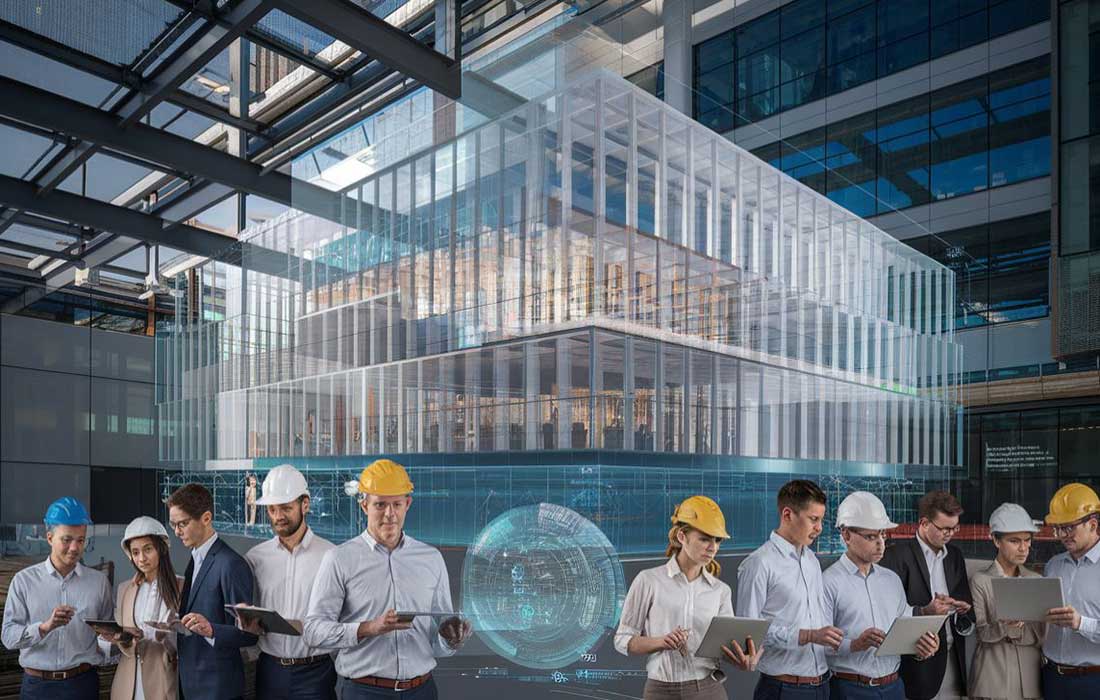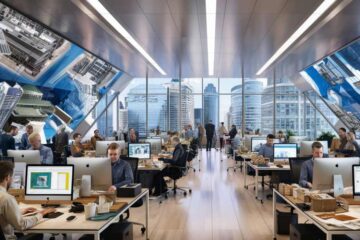BIM in Project Management
Can a digital revolution change how we build? In the construction world, Building Information Modeling (BIM) is leading this change. It’s a powerful tool that’s changing how we manage projects. It helps us plan and execute projects with unmatched precision.
BIM technology is more than just construction management software. It creates a digital copy of a building before we start building. This lets project managers see challenges early, improve designs, and make workflows smoother.

By using BIM in project management, construction companies are getting better at working together and being efficient. This digital method is becoming key in an industry that needs new ideas to handle complex projects and meet deadlines.
Key Takeaways
- BIM enhances project visualization and planning
- Digital twins help predict and solve issues before construction
- BIM improves collaboration among project stakeholders
- Construction efficiency increases with BIM implementation
- Project managers can make more informed decisions using BIM data
Introduction to Building Information Modeling (BIM)
BIM is changing the way we build things. It uses 3D modeling and teamwork to make a full digital copy of buildings.
Definition and Core Concepts of BIM
BIM is all about making and handling digital models of buildings. These models have lots of info, like what the building looks like and how it works. It’s more than just 3D pictures. It also has info on materials, costs, and when things will be done.
Evolution of BIM in the Construction Industry
Over the last 20 years, the construction world has really taken to BIM. It started as a tool for architects but now it’s key for all construction teams. Now, BIM is used from the first design to tearing it down.
Key Benefits of BIM Implementation
BIM brings big benefits to building projects:
- Improved accuracy in design and construction
- Enhanced project collaboration among team members
- Reduced errors and rework
- Better cost estimation and control
- Increased efficiency in project management
By combining 3D modeling and teamwork, BIM makes a single place for everyone to work together. This leads to smoother projects, less trouble, and better results.
The Role of BIM in Project Management
BIM in project management changes how we plan, do, and check on construction projects. It mixes digital tech with old-school building methods. This makes things smoother and more efficient.

With BIM, project managers can make detailed 3D models of buildings. These models hold all project info. This helps with making better choices and managing risks.
BIM helps teams work together better, from architects to contractors. It lets everyone share info in real time. This cuts down on mistakes and misunderstandings in building projects.
“BIM has changed how we manage projects. It’s not just about 3D models; it’s about creating a single place for all project people.”
BIM also makes cost planning and scheduling better. By using detailed 3D models, managers can guess material and labor needs accurately. This leads to better budgets and schedules.
- Enhanced visualization of project progress
- Improved clash detection and issue resolution
- Streamlined documentation and reporting
As construction software gets better, BIM’s role in managing projects will get even bigger. It’s clear BIM is more than a tool. It’s a big change in how we handle construction in the digital era.
3D Modeling and Visualization in Construction Projects
3D modeling changes the game in construction by making digital copies of buildings. This tech helps everyone understand the project better and makes sure designs are spot-on. It’s changing how we plan and build.
Creating Digital Representations of Buildings
Architects and engineers use 3D modeling to make detailed digital copies of buildings. These models show everything from the building’s layout to its systems and materials. Teams can check out every detail of the design before starting construction.
Enhancing Stakeholder Communication
Visuals make complex plans easy to get for everyone. People can explore virtual buildings to see what the finished product will look like. This helps with making better decisions and avoids confusion.
Improving Design Accuracy and Efficiency
3D modeling makes designing faster and more flexible. Teams can quickly try out changes and fix problems early. This saves time and money. Plus, digital twins make sure designs are correct and can actually be built.
| Aspect | Traditional Method | 3D Modeling |
|---|---|---|
| Visualization | 2D drawings | Immersive 3D models |
| Design Changes | Time-consuming | Quick and efficient |
| Stakeholder Understanding | Limited | Comprehensive |
| Error Detection | Late-stage | Early identification |
Using 3D modeling and digital twins, construction projects get better visuals, clearer communication, and work more smoothly. This tech is leading to smarter, more team-focused building projects.
BIM in Project Management: Streamlining Processes
BIM changes how we manage projects in construction by making things more efficient. It works well with construction management software, making teams work better together.

BIM helps with planning and scheduling by creating detailed 3D models. This lets managers see the project before it starts. It helps them plan better and manage time well.
With BIM, updates happen in real time. If something changes on-site, the digital model gets updated right away. This means everyone on the team has the latest info, cutting down on mistakes and misunderstandings.
“BIM has transformed our project management approach. We’ve seen a 30% reduction in rework and a 25% improvement in project delivery times.”
BIM works well with other tools used in project management. Here’s how project management changes with and without BIM:
| Aspect | Without BIM | With BIM |
|---|---|---|
| Planning | 2D drawings, manual calculations | 3D models, automated quantity takeoffs |
| Collaboration | Fragmented communication | Centralized project collaboration |
| Change Management | Time-consuming updates | Real-time model modifications |
| Resource Allocation | Based on estimates | Data-driven decisions |
Using BIM, construction companies can get better at managing projects. This leads to better results and happier clients.
Enhancing Collaboration with BIM Technology
BIM technology changes how construction projects work together. It brings teams closer, making communication easier and workflows smoother.
Real-time Information Sharing
BIM lets everyone get updates instantly. Team members see the latest info, cutting down on mistakes and delays. This keeps the whole team, from architects to contractors, in sync.
Cross-disciplinary Coordination
With BIM, different teams work together smoothly. Architects, engineers, and builders share information easily. They find problems early, saving time and money. This teamwork makes projects run better and reduces issues on site.
Cloud-based BIM Platforms
Cloud-based platforms make construction management software better. They give teams access to project data anytime, anywhere. Team members can work together from anywhere, sharing ideas and solving problems instantly.
| Feature | Benefit |
|---|---|
| Real-time updates | Reduced errors and rework |
| Cross-disciplinary tools | Improved coordination |
| Cloud access | Enhanced remote collaboration |
BIM technology changes how projects work together. It connects teams, makes processes smoother, and boosts efficiency. With real-time updates, teamwork, and cloud access, BIM is changing construction management for the better.
Digital Twins: Bridging the Physical and Digital Worlds
Digital twins are changing how we manage construction projects. They are like virtual copies of real assets, using 3D models and real-time data for simulations. With BIM technology, they give us deep insights into how buildings work and how to keep them running well.

Digital twins have many uses in construction. They let project managers:
- Watch building systems as they work
- See when maintenance is needed
- Use less energy
- Try out different scenarios to make decisions
3D modeling is key to digital twins. Software makes detailed virtual copies of buildings, including everything from walls to wiring. These models help collect and analyze data throughout a building’s life.
“Digital twins are changing how we design, construct, and run buildings. They give us insights and control we couldn’t have before in construction.”
Digital twins help more than just builders. Facility managers use them to make operations smoother, cut downtime, and make building systems last longer. This tech connects physical buildings with digital info, making data flow smoothly and help with decisions at every project stage.
| Digital Twin Feature | Benefit |
|---|---|
| Real-time monitoring | Find issues right away |
| Predictive maintenance | Less downtime and lower costs |
| Performance simulation | Make buildings work better |
| Data integration | Better decision-making |
Clash Detection and Issue Resolution Using BIM
BIM changes how we manage construction by letting us find clashes before we start building. This feature helps teams spot and solve problems early, saving time and money.
Identifying Conflicts Before Construction
With BIM in construction management software, teams can make detailed 3D models. These models show where different parts of the building might clash, like plumbing and electrical systems. Finding these issues early means avoiding expensive problems later.
Reducing Rework and Change Orders
Clash detection greatly reduces rework and change orders. Solving problems in a virtual space means no need for last-minute fixes on-site. This leads to smoother work, fewer delays, and projects that stay on schedule and within budget.
Optimizing Design and Construction Processes
BIM-powered clash detection makes both design and construction better. Designers can improve their plans with clash reports, and contractors can plan more efficiently. This teamwork leads to projects that are better coordinated and of higher quality.
“BIM clash detection has cut our rework by 30% and nearly eliminated on-site conflicts.”
Using clash detection in construction management software helps teams deal with problems early. This makes workflows smoother and projects more accurate and efficient.
Cost Estimation and Scheduling with BIM
BIM changes how we estimate costs and schedule projects in construction. It combines 3D models with cost databases for accurate material quantities and expenses. This means better budget forecasts and less financial risk.
BIM also makes scheduling better. It helps create detailed timelines, considering project phases and dependencies. This leads to better construction sequences and how resources are used.
BIM’s impact on cost estimation and scheduling is huge:
- Increased accuracy in quantity takeoffs
- Real-time cost updates as designs change
- Enhanced visualization of project timelines
- Improved coordination between trades
Let’s look at how BIM stacks up against traditional methods in cost estimation and scheduling:
| Aspect | Traditional Method | BIM Method |
|---|---|---|
| Cost Accuracy | 70-80% | 90-95% |
| Time for Estimation | 1-2 weeks | 2-3 days |
| Schedule Reliability | Medium | High |
| Change Management | Slow and manual | Quick and automated |
Using BIM for cost estimation and scheduling makes construction projects more efficient, transparent, and predictable. It helps project managers make better decisions, leading to successful projects.
Sustainability Analysis and Green Building Design
Building information modeling has changed how we look at sustainability in construction. This tool lets architects and engineers design buildings that use less energy and harm the environment less. By adding sustainability features early, BIM helps buildings get green certifications like LEED.
Energy modeling is a big part of using BIM for sustainability. Designers can test different designs to use less energy. They look at things like how the sun hits the building, insulation, and heating and cooling systems to cut down on carbon emissions.
BIM also helps teams check how a building affects the environment. They can look at materials, water use, and waste plans. This makes sure projects meet sustainability goals from start to finish.
“BIM has transformed our ability to create truly sustainable buildings. It’s not just about energy efficiency anymore; it’s about holistic environmental design.”
Using BIM for sustainability goes beyond single projects. It helps cities plan for more sustainable buildings and lowers their environmental impact.
- Optimize energy performance
- Reduce water consumption
- Improve indoor air quality
- Enhance material selection
As making buildings sustainable becomes more important, BIM will be key in green building design. It gives detailed analysis and simulations. This makes it a must-have for building structures that are good for the planet.
BIM Implementation Challenges and Best Practices
Using BIM in project management has big benefits, but it comes with challenges. Many construction companies struggle when they start using this technology. Let’s look at the common problems and how to get past them.
Training staff is a big issue. Construction workers often find it hard to learn new software and methods. Companies should spend on detailed training programs. These programs help workers understand BIM and use construction management software well.
Integrating technology is another big challenge. Old systems might not work well with BIM tools. Companies need to check their current setup and pick BIM solutions that fit. This makes sure data moves smoothly and helps get the most out of BIM in managing projects.
Changing how a company works is key to making BIM work. If people resist new ways of doing things, progress can slow down. Leaders must support the change, explain its benefits, and get staff involved in the change process.
| Challenge | Best Practice |
|---|---|
| Staff Training | Implement ongoing learning programs |
| Technology Integration | Choose compatible BIM solutions |
| Change Management | Engage leadership and involve staff |
By tackling these challenges, construction firms can make the most of BIM in managing projects. With careful planning and action, BIM becomes a key tool for improving efficiency and teamwork in construction.
Future Trends in BIM and Project Management
The world of building information modeling (BIM) is changing fast. Artificial intelligence is making BIM processes smarter, automating tasks and helping with decisions. This will lead to better project management in construction.
Augmented reality is changing the game for BIM. It lets teams see 3D models in real life, finding problems early. This tech closes the gap between digital plans and actual building, making things more accurate and helping teams work together better.
BIM is playing a bigger part in making smart cities. Digital twins, which are like virtual copies of real buildings, are key for planning and managing cities. They help cities use resources better, predict when things need fixing, and make cities more sustainable.
As BIM gets better, it will work better with other digital tools. This will make managing projects smoother, from start to finish. The future of building is all about these digital tools, promising projects that are more efficient, sustainable, and cost-effective.
Related Article : Exploring the Benefits of BIM For Facility Management
BIM In Project Management FAQs
What is Building Information Modeling (BIM)?
Building Information Modeling (BIM) is a digital way to show a building’s design and how it works. It uses a 3D model that combines design, engineering, and project management info.
How does BIM improve project collaboration?
BIM makes sharing info easy among project teams. It helps everyone work together better by using a cloud-based platform. This makes talking and making decisions faster.
What are the benefits of 3D modeling and visualization in construction projects?
3D modeling and visualization with BIM give a clear view of buildings. This helps everyone understand the project better. It also makes sure the design is correct and saves time.
How does BIM streamline project management processes?
BIM makes planning, scheduling, and managing resources easier. It works with other tools to help coordinate and run projects better.
What is a digital twin in the context of BIM?
A digital twin is a BIM-made copy of a real building. It connects the real and digital worlds. This lets us watch and improve building performance over time.
How does BIM help with clash detection?
BIM finds conflicts between building parts before they start building. This cuts down on extra work and mistakes, saving time and money.
Can BIM improve cost estimation and scheduling?
Yes, BIM makes cost planning and scheduling better. It uses cost data and scheduling tools for more precise costs and timelines based on the digital model.
How does BIM contribute to sustainability analysis and green building design?
BIM helps with green building by doing energy modeling and checking environmental impact. It supports LEED certification and sustainability goals with accurate simulations and data.
What are some challenges in implementing BIM?
Challenges include training staff, fitting technology together, and changing how the organization works. Success comes from good training, easy system integration, and a clear plan for change.
What are some future trends in BIM and project management?
Future trends include using AI and augmented reality, and BIM’s role in smart cities and managing infrastructure. BIM will be key in making smart, sustainable buildings.



